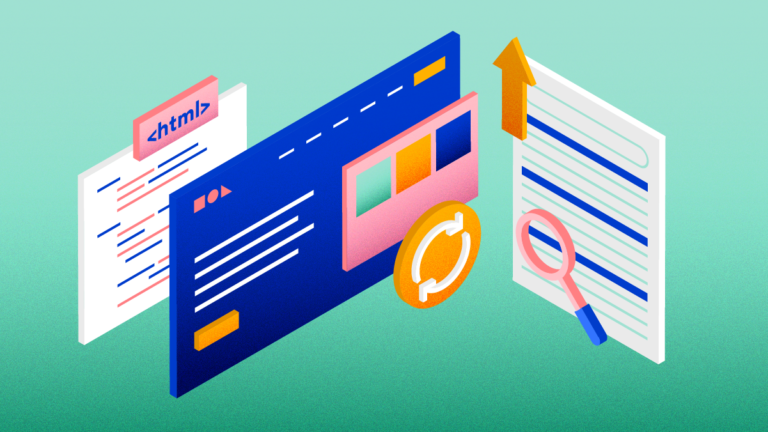How to maintain SEO traction during a website redesign: 7 tips

When it comes to driving website conversions, Search Engine Optimization (SEO) plays an important role. An SEO-friendly website that ranks high on the Search Engine Results Page (SERP) can attract more organic traffic and ultimately create more opportunities for conversions.
But you can’t climb the SERP overnight. Copy, design, development, and many other factors all work together to deliver a superior user experience that Google recognizes and rewards.
When you redesign and launch a new website, it’s normal to experience a dip in SEO performance. Changes to the sitemap, keyword strategy, 301 redirects, and other factors have the potential to negatively impact performance. But there are strategic steps you can take to minimize the impact and set your website up for long-term SEO success.
What contributes to a good SEO score?
Your SEO score is affected by many factors, not just keywords. Google uses a complex algorithm to assess the quality of the overall user experience. Relevant keywords, easy-to-understand copy, internal linking, page speed, and more all contribute to the score. And unfortunately, there is no SEO silver bullet.
Google can see right through poorly planned and built websites – including keyword stuffing (attempting to manipulate Google’s algorithm with excessive keyword insertion) and clunky site navigation.
In fact, the algorithm gets smarter every day. On average, Google’s algorithm changes more than 500 times per year. That’s why it’s not only advised but essential to regularly evaluate your website’s SEO performance and discover new ways to optimize.
7 tips to help you maintain (and gain) SEO traction during your website redesign.
Taking the time to map out your SEO strategy at the beginning of your website redesign can have a positive compounding effect in the months and years following launch. Keep these tips in mind as you start your redesign process.
1. Benchmark your current website performance
Before you begin redesigning your website, make sure you understand where you’re starting from. Investigate what is and isn’t working by reviewing yearly, weekly, and daily site metrics with tools like Google Analytics and Google Search Console. Go through page by page and measure:
- Page visits (unique visitors, visitors, and visits)
- Time spent on page
- Bounce rate
- Top-performing keywords
- Exit rates
Manage expectations by comparing your website against your competitors and your industry average. Based on your research, decide which pages you should discard, rewrite or add.
2. Set your SEO goals
When coming up with your SEO game plan, take inventory of your benchmark data to determine your website redesign goals. Ensure every goal is realistic and steeped in solid data. Consider these goals and strategies:
- Goal: Increase engagement on core pages
How: Create relevant, easily digestible content that tells a clear story on each webpage. Include compelling CTAs and internal links to guide users to other relevant pages. - Goal: Improve domain authority
How: A higher domain authority allows you to compete for more competitive keywords. To improve domain authority, increase the number of relevant backlinks to your website (and remove low-quality or spam links), upgrade the quality of your content, and invest in a social media strategy to generate more visits to your website. - Goal: Increase website conversions
How: Clearly communicate your unique differentiators, build credibility with testimonials and case studies, and guide users to the call-to-action. Track conversions and the specific path the user takes to get to them to understand what’s working and where you can improve. - Goal: Decrease bounce rate on core pages
How: Improve page load speeds by fixing technical coding errors and optimizing images. Write concise, relevant copy that will engage users and encourage them to keep exploring your site.
Remember that your SEO goals should complement your business goals. Create your website redesign plan in conjunction with your overarching business plan and always define how success will be measured.
Once you’ve solidified your vision, it’s time for the groundwork. Research competitor keywords and review actual user search queries to gain insights into how you might want to evolve your sitemap.
3. Define your sitemap and user journeys

Busy website navigation can bury important information and frustrate users. Prune and re-organize your sitemap and menu structure to reduce site clutter and help your users (and Google) find focused, relevant content.
Review the analytics of any pages you’re planning to remove to determine whether keywords on these pages are driving organic web traffic to your site. If the keywords are still valuable, but the pages aren’t contributing to conversions, consider migrating the page content into resources.
We actually went through this process recently ourselves. When we redesigned the Tiller website, we discovered that very few of our service pages were driving conversions. The copy was still educational and included relevant keywords, so we used it to create new blog articles and glossary terms. This allowed us to consolidate our sitemap and streamline the user journey, while still leveraging keywords. We were pleased to learn that this approach was successful: there was no drop in organic web traffic post-launch (analysis completed at three months and six months).
For new or optimized pages, conduct keyword research to identify relevant search terms with high search volume. Google rewards pages that easily and thoroughly answer search queries, so assign specific keywords to core pages to bring a specific focus to each page.
Help users glide through your website by adding relevant internal links that guide them to the next page in the journey. Examples include adding a link to your ‘Careers’ page on your ‘Our Story’ page or a ‘Get a Demo’ link to your homepage. Keep in mind that overusing internal links can have the opposite effect and create confusion for users.
4. Optimize for on-page SEO
On-page SEO refers to SEO factors and strategies on your website. Off-page SEO factors and strategies are outside of your website domain (e.g. a guest blog post with a backlink to your website). The goal of on-page SEO is for search engines like Google to easily find your website and push your page up the SERP. But it’s not just about bringing in traffic.
On-page optimization aims to attract the right users to your site and drive them to convert. Conversions include everything from submitting a contact form or requesting a demo to purchasing your product or service.
Successful on-page optimization is the cumulation of many factors. Here are just a few:
- Title tags: This snippet of code names your page and helps your website stand out to Google on the SERP. Make sure your title tag clearly describes your page content as this is what users will read when deciding which website to visit.
- Meta descriptions: Meta descriptions summarize your page content and give your searchers a preview of what they’ll learn on that specific page.
- Alt text: Alt text is used in HTML code to describe a visual asset. Not only is alt text important to communicate the image to visually impaired users, but it also helps Google understand and index images.
- Site speed: If your page takes too long to load (more than 3 seconds), your users won’t hesitate to hit the back button. Optimize image sizes, reduce the number of plugins, and implement redirects.
- Responsive design: At any given moment there are more mobile web users than desktop, so Google indexes the mobile version of your website first. Optimize your website for mobile to ensure users (and Google) enjoy a consistent, positive experience on every device.
- URL keywords: Include a keyword in page URLs to help search engines understand the intent of each page.
5. Create high-quality content
It’s important to strike a balance between conversational copywriting and hitting your keyword quota. After all, there’s no point in bringing in an enormous volume of traffic to your website if nobody converts. When in doubt? Write for humans. You’re better off focusing on enhancing the user experience than trying to outsmart Google. Happy user = happy Google.
Here are a few tips when writing SEO-optimized content:
- Keep writing clear, concise, and focused
- Write for your target audience, not yourself
- Never keyword stuff
- Make your content skim-friendly with bold headlines and snappy subheadings
- Break up your content with bulleted lists and digestible paragraphs
6. Don’t forget about redirects (301 errors)
Removing pages with valuable third-party backlinks (a link from a website with a high domain authority) can negatively impact your SEO score. Adding 301 redirects can help you avoid this. When you move or delete a webpage, 301 redirects ensure traffic flows uninterrupted to the new page rather than a 404 error page.
As one of the biggest culprits of a poor SEO score, redirects can go unnoticed. If your SEO has suddenly taken a plunge, check for 301 errors first. Unsure if your pages have third-party backlinks? Check out an SEO tool like Semrush.
7. Conduct pre and post-launch SEO Quality Assurance (QA)
We highly recommend a thorough pre-launch SEO QA to ensure your website is set to go live. This will allow you to catch high-risk (but easy to fix) issues like redirects or broken links.
Post-launch, it’s equally important to continue optimizing your new website for SEO. Remember that performance issues like low domain authority require long-term investment in high-quality, relevant content and backlinks.
Because human error is, well, human, here are a few of the SEO tools we use at Tiller to fortify our SEO QA process:
- SEMrush
- Ahref
- ScreamingFrog
- Google Search Console
SEO is a journey, not a destination.

Implementing proven SEO best practices into your website redesign process will not only improve your user experience but will also increase your SERP ranking. More visibility. More opportunity. More conversions.
Website redesigns can be daunting. But with the right strategic partner by your side, you can redesign your website with confidence and climb the SERP ladder one step at a time.
Keep in mind that nobody can wave an SEO magic wand – not even your SEO agency. Instead, look for agency partners who will actively engage in measuring and optimizing your website for long-term SEO gain.



